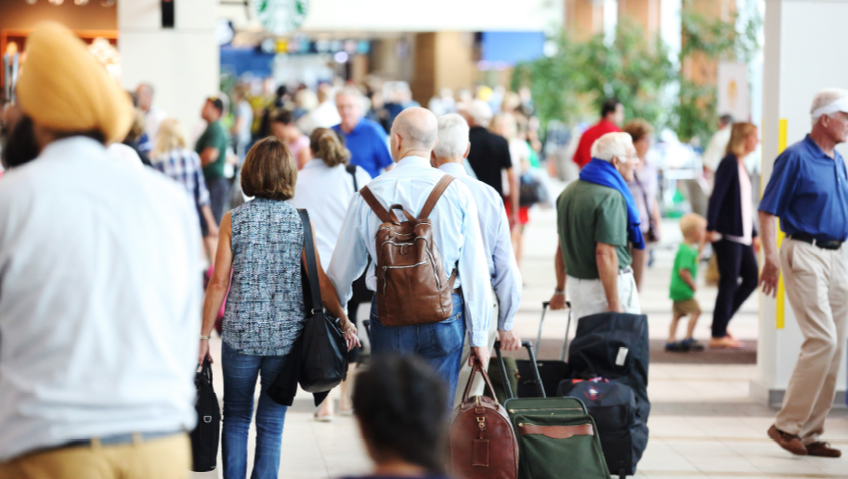It goes without saying that a global pandemic wreaks havoc on tourism. The COVID-19 shutdowns and travel restrictions plunged the travel and tourism industry into an unprecedented crisis as people stayed home to avoid the spread of the virus.
The good news is that international tourism has enjoyed a remarkable recovery since the height of the pandemic. Wanderlust has proven a powerful force, allowing the industry to rebound dramatically. Between January and July 2023, international tourist arrivals reached 84 percent of pre-pandemic levels, according to the World Tourism Organization, (UNWTO) a United Nations Specialized Agency. In fact, UNWTO has found that tourism is “on track for full recovery,” demonstrating impressive resilience despite post-COVID geopolitical and economic pressures.
Between January and July 2023, 700 million tourists traveled internationally, a 43 percent increase from that same time period the previous year, UNWTO reports. During those first seven months of 2023, July was the busiest time, with a total of 145 million international travellers recorded.
When it comes to the United States, July 2023 air travel demand increased 12 percent from the previous July, according to the U.S. Travel Association. Total travel spending has remained 1.2 percent higher than 2022 levels for three months running, and is 4.1 percent higher year-to-date through July 2023. Overseas arrivals to the United States continued to improve over the summer and, as of July, were 22 percent below 2019 levels.
As of August 2023, hotel demand in the U.S. had just about stayed the same as the previous year’s for three consecutive months and travel prices were almost the same as in July 2022. The cost of gas and airfare decreased, while food, lodging, and recreation costs “remain somewhat elevated,” the U.S. Travel Association reports.
All regions of the globe experienced a notable rebound within the tourism sector over the first seven months of 2023. The Middle East, Europe, and Africa led the global recovery during this period. The Middle East enjoyed remarkable growth, with arrival levels coming in at 20 percent above pre-pandemic levels, according to UNWTO. While the region is the only one to exceed 2019 levels thus far, other world regions also enjoyed significant comebacks.
Recovery in Asia and the Pacific has reached 61 percent of pre-pandemic arrival levels. Europe, which is the world’s largest destination region, achieved 91 percent of its pre-pandemic levels, particularly due to intra-regional demand and travel from the United States, UNWTO reports. Africa regained 92 percent of its pre-pandemic tourists and the Americas recovered 87 percent. McKinsey & Company points out that this growth is particularly significant because it was achieved without travelers from China, which had the biggest outbound travel market before COVID hit. UNWTO predicts that the reopening of China and other Asian markets and destinations will significantly boost travel globally, as well as within the region.
Looking ahead, international tourism is on its way to reaching between 80 and 95 percent of pre-pandemic levels in 2023, according to UNWTO. The period from September through December 2023 is likely to see continued recovery, “though at a more moderate pace” than that achieved during the peak travel months of summer. This increase “will be driven by the still pent-up demand and increased air connectivity” post-COVID, particularly in Asia and the Pacific where recovery has progressed at a slower pace.
Despite ongoing challenges, there is already encouraging news regarding a “substantial resurgence” in China’s travel and tourism industry, the World Travel & Tourism Council (WTTC) reports. The council’s latest Economic Impact Research reveals that China’s travel and tourism sector is expected to contribute $1.48 trillion to the national economy by year’s end, an increase of over 150 percent from last year, when the sector added $583 billion to the economy.
UNWTO’s Panel of Experts foresees that today’s challenging economic environment will continue to be a “critical factor” in international tourism’s recovery and identifies the current economic situation as the primary issue affecting the state of international tourism in 2023. Rising oil prices and persistent inflation have led to higher transportation and accommodations costs, which could have an impact on spending patterns over the next several months. Tourists will likely be seeking greater value for money, staying closer to home while traveling and taking shorter trips, UNWTO predicts. Geopolitical forces are also at work, creating additional uncertainty and influencing travelers regarding international travel destinations.
The travel and tourism sector is also facing the challenge of a widespread labour shortage. In 2020, while reeling from the immediate effects of the pandemic, impacted businesses had to cut back their workforce to survive. The number of jobs supported by the sector plummeted from 333 million jobs in 2019 to 271 million jobs in 2020, an 18.6 percent drop, according to WTTC. These numbers increased by 6.7 percent in 2021 to 289 million workers as travel restrictions lifted.
As the sector continues to recover, it will need a reliable workforce to support its growth. But workforce shortages remain, making it “incredibly difficult” to find employees to fill a rising number of job openings, WTTC reports.
One complication in regaining pre-pandemic staff numbers is that many employees that were laid off by the travel and tourism sector found work within another industry or exited the workforce completely, according to WTTC. Consequently, the travel and tourism sector must now compete with other industries to attract much-needed workers.
Also critical is that pandemic travel restrictions have caused a reduction in the number of migrant workers available for employment by the industry. Before COVID hit, foreign-born workers made up almost 20 percent of the United States’ tourism workforce and 16 percent of the United Kingdom’s and the European Union’s, WTTC reports. The situation was similar in Canada, and research-based bodies such as Tourism HR Canada are making research into the migrant workforce a priority (see Building a Better Workforce Through Better Research in this issue).
Filling some jobs within the sector will prove more complicated and time-consuming than others. For example, the aviation industry requires that pilots complete comprehensive training and meet demanding security requirements, which often include a long wait for a government-issued security clearance, WTTC points out. The pandemic halted these processes, creating consequences down the road that are now evident.
Indeed, WTTC identifies workforce shortages as a “key issue” for the travel and tourism sector and warns that recovery and future growth require solving this problem to meet the increasing demand for travel. To address the challenge, WTTC recommends the implementation of policies within the public and private sectors that enable labour mobility, facilitate flexible hours and remote work, provide competitive benefits, develop and bolster a skilled workforce, encourage opportunities within the sector, increase collaboration within the sector, and embrace new technologies. Tourism HR Canada places a similar focus on workplace culture, aiming to “nurture [a] strong and supportive workplace culture industry-wide by promoting the growth of a dynamic and adaptable workforce while enabling HR development initiatives for a globally competitive business.”
While challenges certainly remain, the outlook is overwhelmingly positive for the travel and tourism sector, considering how hard hit the industry was just a few years ago. Since then, the sector has enjoyed a remarkable resurgence as people around the world have eagerly taken advantage of returning travel opportunities after COVID restrictions lifted. With numbers increasing steadily since the pandemic, there is certainly reason to remain optimistic despite ongoing workforce shortages, economic issues, and other lingering concerns. For while the future cannot be known, one factor is certain: people around the globe have a persistent desire to travel, regardless of the obstacles.






